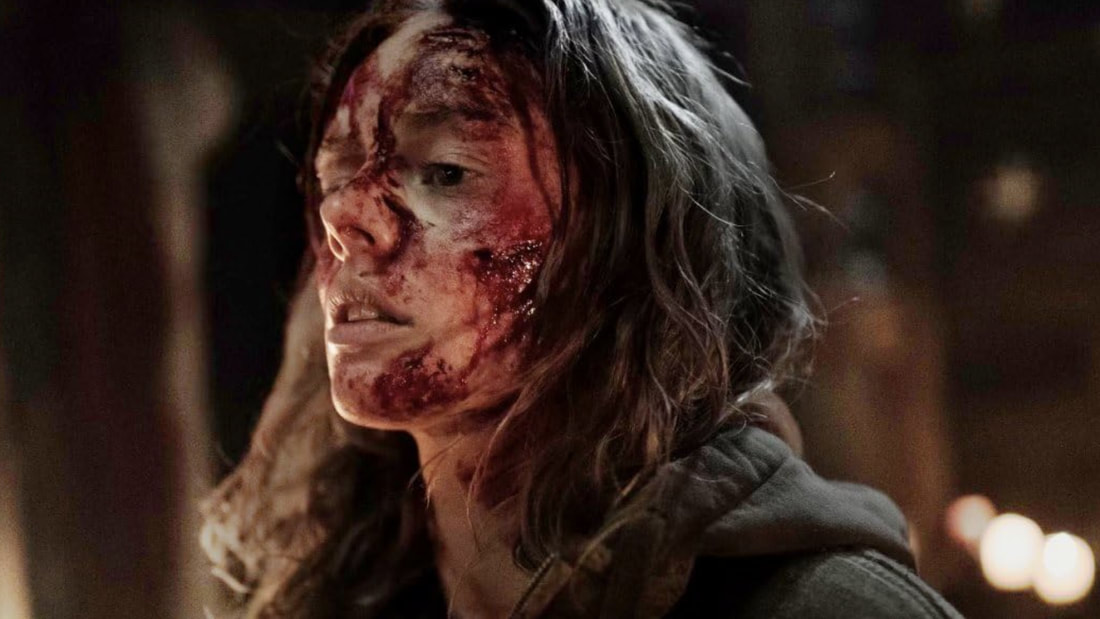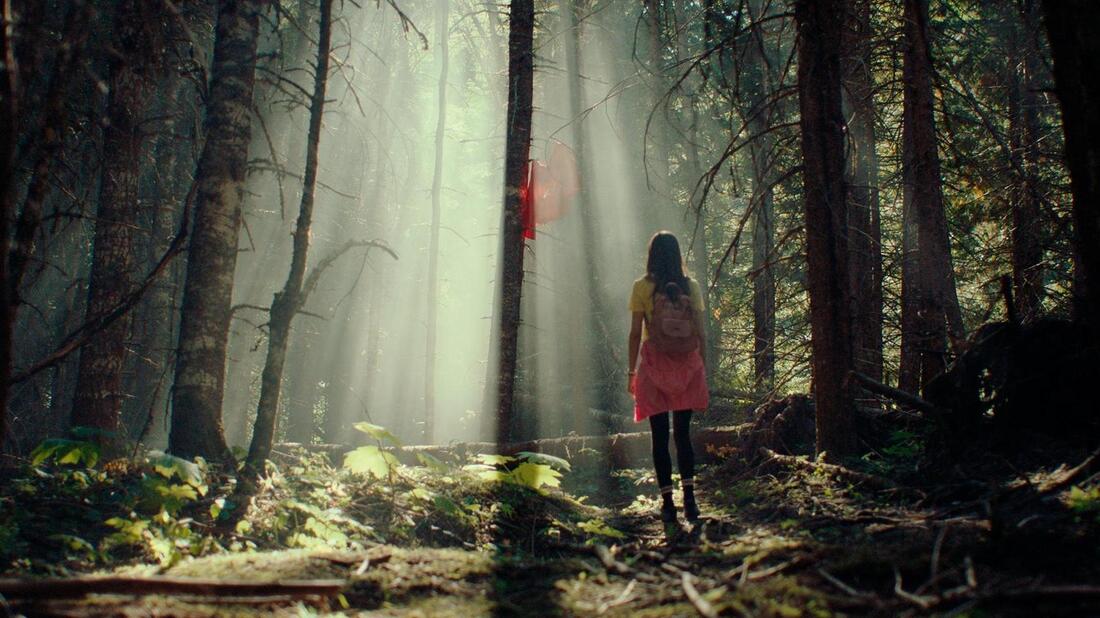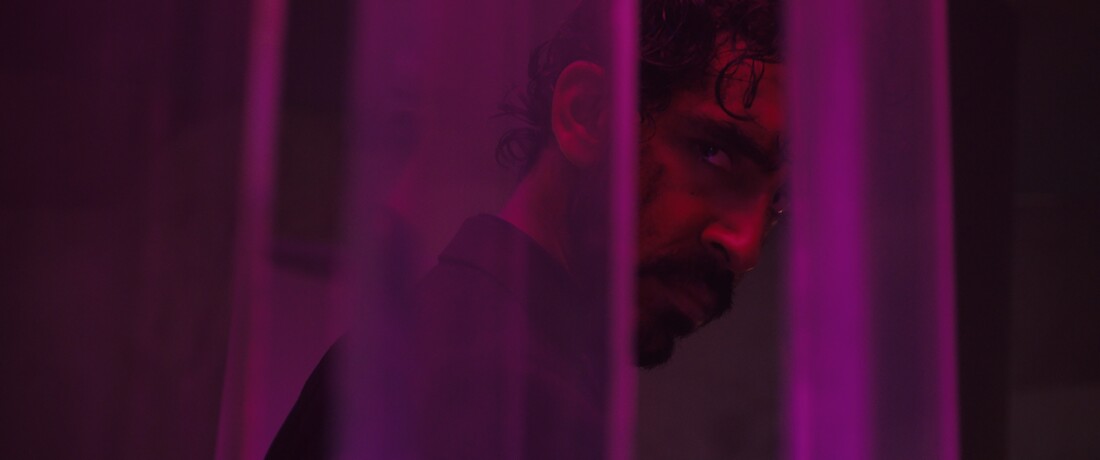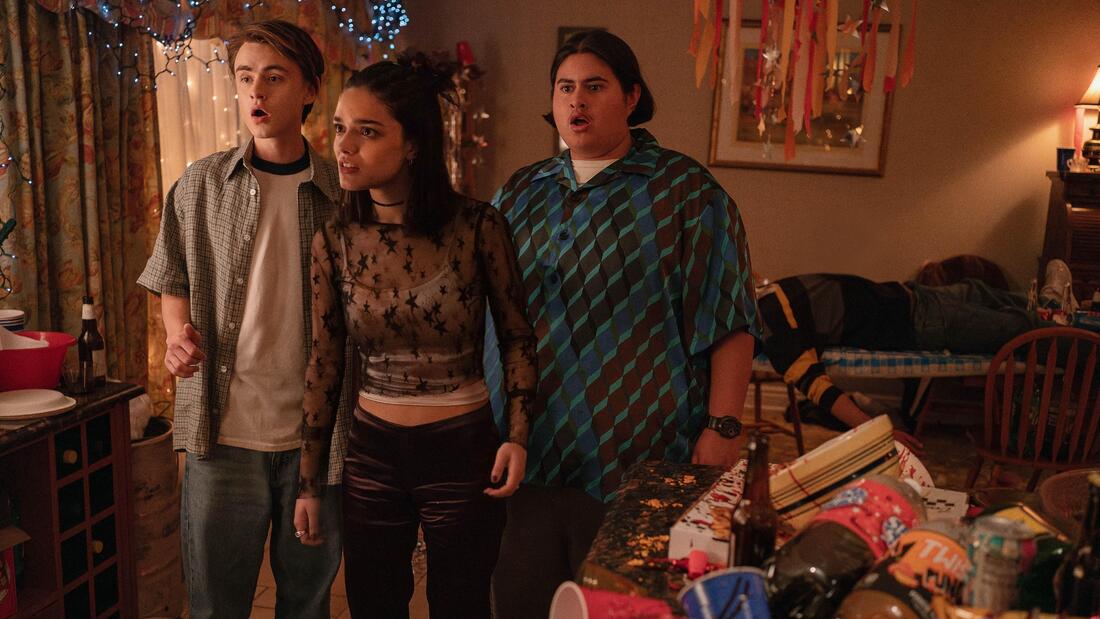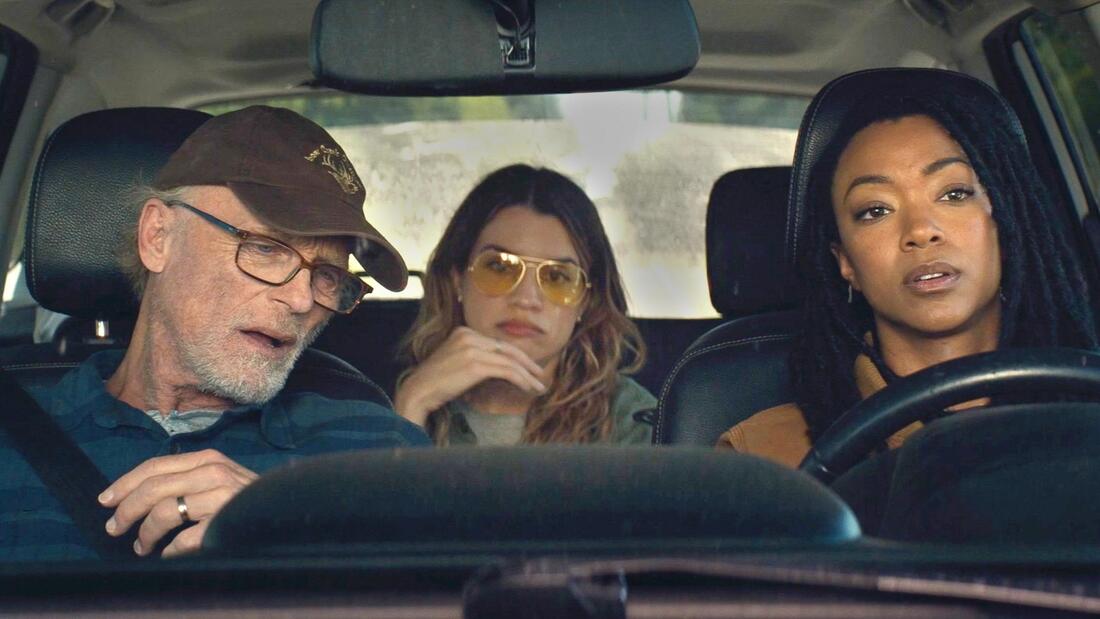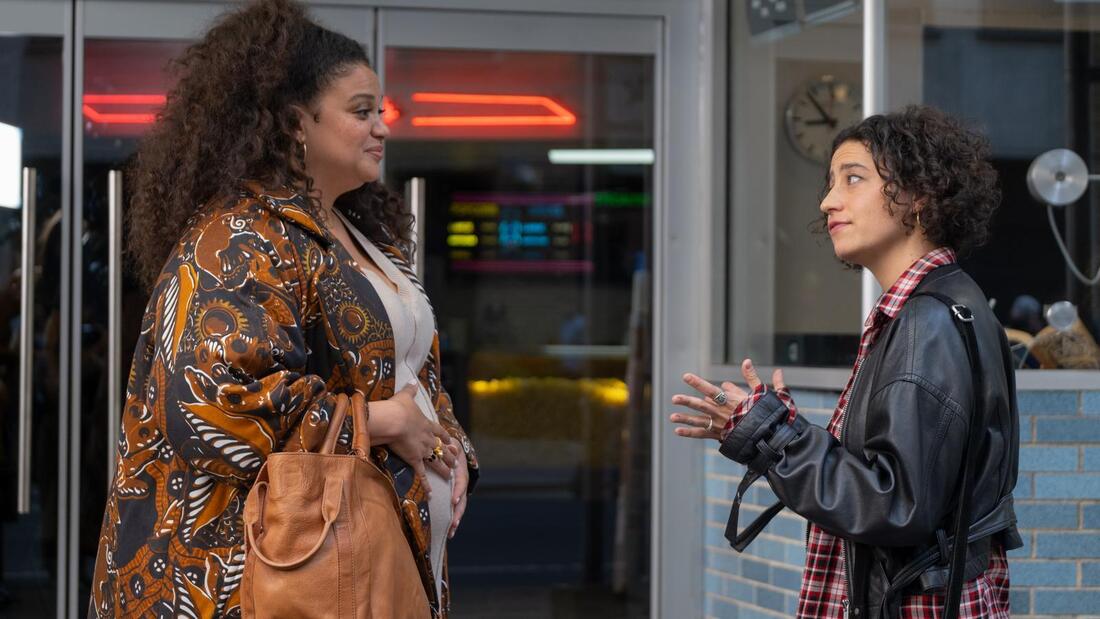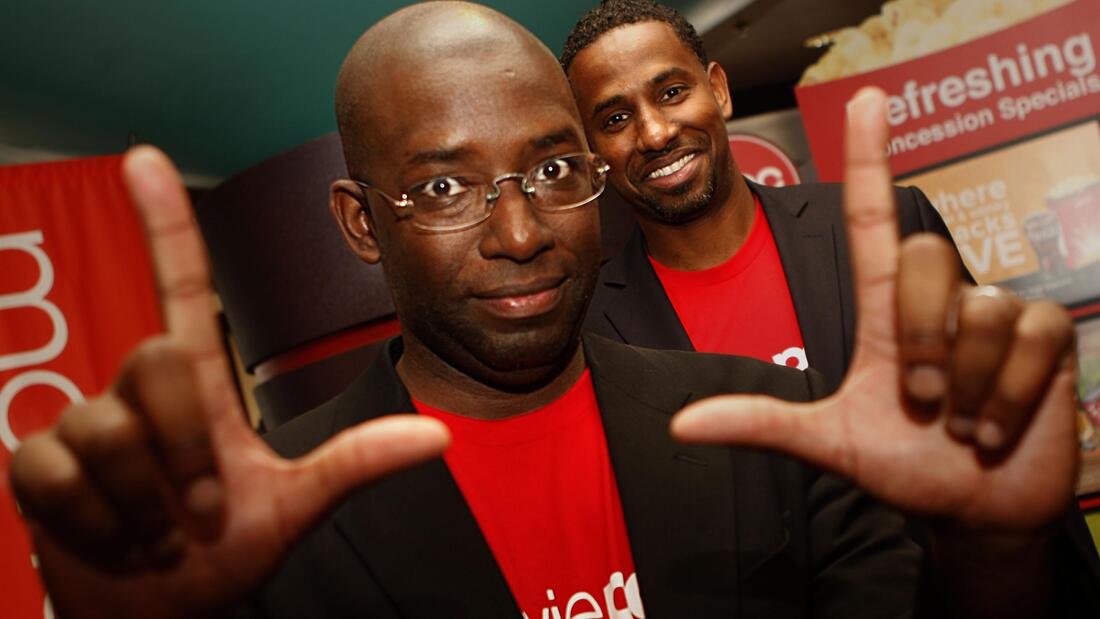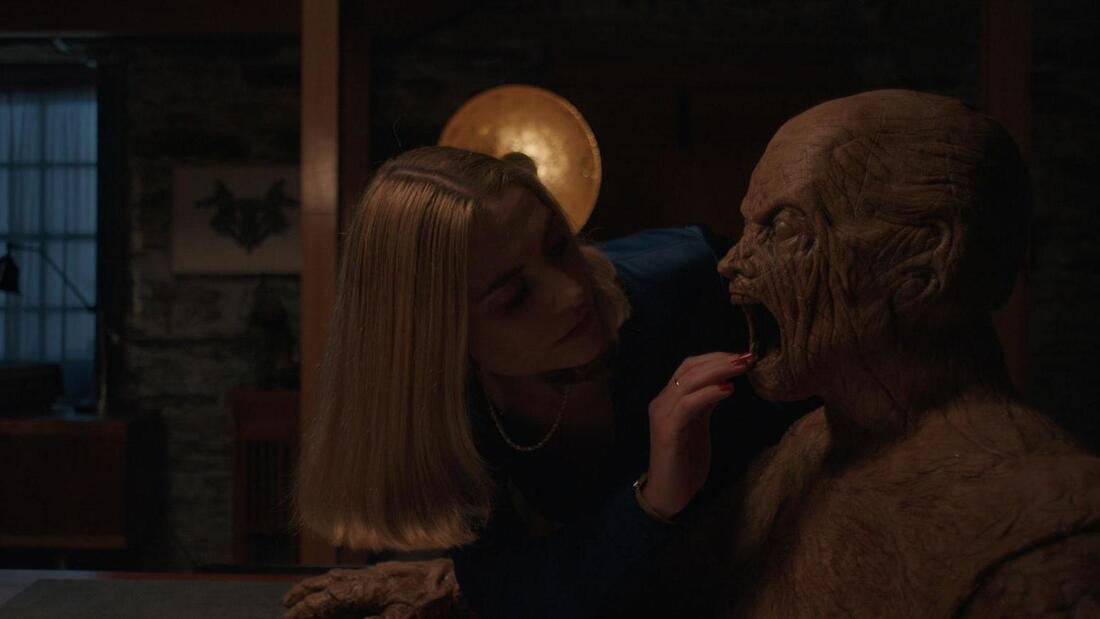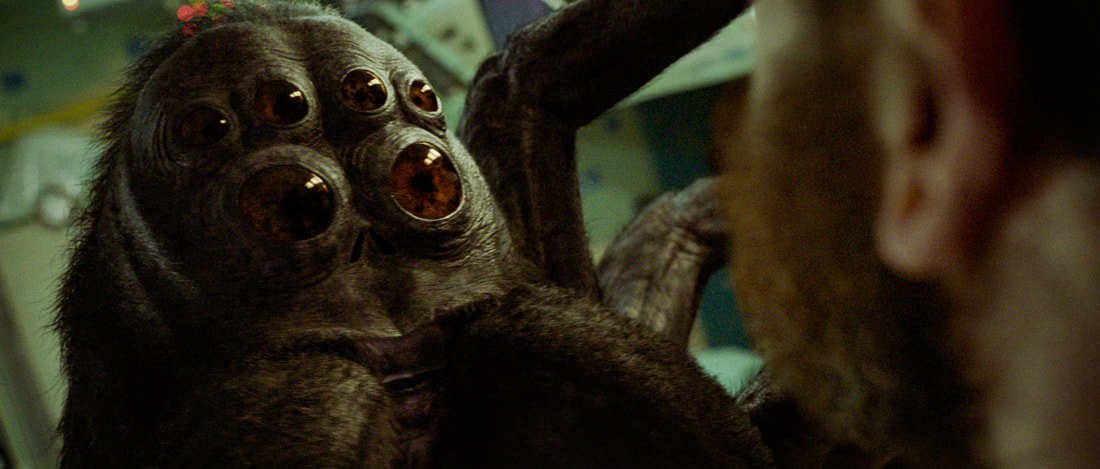|
Review by Jonathan Berk There are two big reasons to see Azrael: Samara Weaving and the visual effects. These two elements are undeniable. However, if you care about character motivation, story logic, or the rules of the world, Azrael will leave you wanting. It's frustrating to watch something that feels like style was chosen over substance time and time again. Some moments may wow the audience, but the next will leave you confused, frustrated, and unclear.
The apocalypse has happened, and years later, a cult of mute zealots captures Azrael (Samara Weaving) and her love. They appear to want to sacrifice her to something, but it's unclear exactly what. The ritual is performed, and a crispy-looking creature shambles towards her. She breaks free and pushes a zealot into the creature to escape. This sets the two forces on each other as she seeks to save her love, and they seek to kill her. The creatures in this film are the prime example of the lack of clear rules. Ignoring the issues of classification (is it a zombie, demon, monster, or something else entirely?), how they operate is completely unclear. It is shown that they are attracted to the scent of human blood. However, the first time we see this is when they slice Azrael's leg open with a razor to lure it to her. One arrives and moves with no real sense of urgency. Yet, later on, the creatures run towards her. They appear insatiable, but for the movie's sake, they pretend to leave in one moment only to pounce seconds later. While the "scare" effect is evident in moments like that, it undercuts any sense of world-building. These issues are not exclusive to the monsters. There is almost no dialogue because the majority of the characters are mute. Yet, multiple times, they seem unable to hear for the plot's sake. A creature basically tap dances its way toward a character who doesn't hear anything until it's almost too late. Don't worry, though; this creature appears to lose interest for no reason shown in the movie. So many moments like this are stitched together as part of the tapestry of the story, only to be undone later. After Azrael's initial escape, she stumbles upon a river. The movie then cuts to a camera shot that pushes through a waterfall up to Azrael in this very cool-looking moment. It feels like a POV of something approaching her, but then it cuts to the other shot, and she's just in the river. The shot looks cool but offers nothing. That's a great metaphor for this movie. All of the stuff seems cool, but ultimately, it amounts to nothing. Azrael is probably a little better than I am willing to give it credit for. The thing is, if you are creating the world of the film, you get to control the rules. So, if you want something to be a certain way, you can write it like that. However, if you want to keep your audience on the same wavelength, consistency in those rules usually helps. Azrael is screening at the 2024 SXSW Film Festival, which runs March 8-16 in Austin, TX. Rating: 2.5/5
0 Comments
Review by Jonathan Berk Kryptic tries to tell a weird and twisted story in the vein of a David Lynch film. However, just having a collection of weird things in a world that constantly changes for no apparent reason doesn’t make it Lynchian. Director Kourtney Roy’s film has many issues, and no amount of Croenenberg-style goop can salvage it.
The film starts with a group of women meeting to walk a trail in the Kryptic mountains. Over the course of a guided hike, Kay Hall (Chloe Pirrie) goes missing. She soon returns and everyone is mad because it ends the tour abruptly. Her temporary disappearance started as she was fixated on a location where another woman had previously gone missing while searching for a mythical creature. It becomes apparent, however, that this may not be Kay Hall at all. Pirrie is really good in this movie and appears to be game to do whatever Roy has in store for her. In that opening sequence, “mucus” excretes from her ears and pours down the side of her face. That’s just the beginning of the fluids appearing in large quantities in the film. Pirrie’s character shifts and changes multiple times, as does the story. Pirrie’s handling of the changes in her character is impressive, but that is not the case for the story. There are many scenes strung together that are actually just boring. Pirrie’s character has drinks with a woman, who then vanishes from the film. She leaves that location and goes to another further down the road. Then, she has drinks with a woman who then vanishes. This is repeated two more times, with basically nothing happening of any interest in these scenes. The conversations slightly allude to an idea of a theme, but it’s never really developed outside of these moments. That rings true time and time again. What is the deal with the creature? Who is our main character, really? Why does that guy have an ascot? Audience members will likely be baffled and probably frustrated by any attempt to answer the many questions the movie poses. There are definitely films that aren’t concerned with cohesive or causal storytelling. Those films can work or may offer some other reason to keep the audience engaged and watching. That just isn’t the case here. Kryptic tries many things and doesn’t do any of them well. It’s a disservice to the lead actress, who does give it her all. Her performance is the one thing that audiences will likely enjoy. The first twenty minutes or so are interesting. The film definitely thinks it is clever, especially what it decides to offer as the ending, but it’s just not. If you want unique or weird horror, check out David Lynch’s Eraserhead or Quentin Dupieux's Mandibles. Kryptic is screening at the 2024 SXSW Film Festival, which is running from March 8-16 in Austin, TX. Rating: 1.5/5 Review by Jonathan Berk Documentary biographies can be pumped out pretty quickly in a paint-by-numbers fashion. Those can be entertaining and informative, even if they aren't looking to do anything new. Despite the possibility of those working, it's far more common for them to feel like a slog, as the filmmaker opts to deliver a checklist of accomplishments while never really delivering a sense of who that person's personality is. Fortunately, directors Julia Greenberg and Dianna Dilworth found a unique way to deliver their documentary, Dory Previn: On My Way to Where, providing what feels like true insight into the film's subject.
Combining archival footage, journals, animation, and just a few talking head interviews with tons of music and interesting sound design, the documentary gets to the heart of who Dory Previn was. As a singer and songwriter, Dory notoriously didn't shy away from exactly who she was, but the documentary provides incredible access via her journals to explore this idea even more. It seems her diary would appear on screen- sometimes stylized, often with animated doodles - and a voiceover actress would read the words that offered insight into various moments of Dory's life. By the end of the film, the audience is left feeling like they've been in a 70-minute conversation with the woman herself. Audiences can go into this documentary without knowledge of the subject and walk out feeling like they've known Dory all their lives. This isn't a comprehensive list of everything she did, which would feel impersonal. You probably don't know your best friend's full resume unless you have experienced it with them. Instead, you just know them, what kinds of choices they would make, and probably the rationale behind them. That's what this film manages to accomplish. It's not attempting to give you the full picture of her actions but rather why she did them. This feels far more important and will likely make the film linger in your mind for days, much like after the parting from a loved one; that feeling of absence lingers. The technical aspects of this documentary are also quite impressive. People often don't think of documentaries as a genre that allows for much creativity. Many, especially in the last several years, have pushed back against this idea. Film is a visual medium, despite the genre being displayed. As mentioned, the film's use of animation and text is impactful. They reduce the distraction and force us to focus on the words being said. The journals were primarily Dory's conversation with Mama, Max, and a lion. The context behind those three figures and their animated counterparts is further explained in the film. You'll not forget this stylistic choice. Dory Previn: On My Way to Where is a documentary that refuses to be forgotten. It's not loud or bombastic, but it is inviting and confident. The filmmakers are aware of what they have available, and they've found a great way to share it with the world. Much like the musical biopic has come under an abundance of critical disdain, a biographic documentary often brings a similar hesitation. However, this is NOT just another one. Dory Previn: On My Way to Where is screening at the 2024 SXSW Film Festival, which runs March 8-16 in Austin, TX. Rating: 5/5 Review by Jonathan Berk Dev Patel doesn't need to be James Bond because he is Monkey Man. The actor's directorial debut wears its influences on its sleeves in the best way imaginable. Fans of the action genre and martial arts films spanning back the last fifty years will see homage to many classics in Patel's new film. While he has been a star for almost twenty years since breaking out in Slumdog Millionaire, he shines just as bright behind the camera. There is room to adjust the pacing, but once the film is in the third act, it becomes undeniable. Patel plays Kid, an anonymous young man making a living in any way he can. Driven by a trauma from his past, Kid is working to infiltrate the corrupt rulers of the city. He is stymied at every turn until something inside snaps and turns his scarred hands into weapons of retribution. The influence of classic action cinema on Monkey Man is apparent. Audiences can catch a fair number of Bruce Lee movie references in some of the later fight sequences. For example, there is a clear nod to Enter the Dragon, and the general structure of the plot leans on Game of Death in some obvious ways. An incredible sequence with an axe and a shot later feels in Oldboy's vein. The John Wick comparisons will be there because of some of the cinematography and action style. Plenty of other references can be found, but they all add up to Patel's clear vision. Patel and his crew find some very innovative ways to use the camera. There will be shots in Kid's POV that cut on impact to a wide shot. The camera goes into or behind objects that then get used as a moment of impact. The earlier fights feature a lot more cutting from one shot to another, and the later fight goes with extended takes and much wider framing. All of these choices help to give a kinetic touch to the story. Anyone questioning if Patel was up to the task of directing will get their answer: a resounding YES.
Patel has done some action movies in recent years with Hotel Mumbai and The Wedding Guest, but those now seem like his real-life training montage. He showcases his charm, fighting ability, and muscles throughout the film. He has always been incredible at emoting, and that is no different here. The story has plenty of emotion, and Patel delivers so much on that front. When he lands punches, you can't help but cheer because there is righteous fury behind them. Monkey Man was an exhilarating experience. It is clear from both the film itself and the amount of talking Patel did at SXSW that this was a major passion project. There is so much love in the story and some crafty filmmaking. Some very cool production design elements only heighten the overall style. Monkey Man premiered at the 2024 SXSW Film Festival, which runs March 8-16 in Austin, TX. Rating: 4.5/5 Review by Jonathan Berk It's 1999, and just a few short hours before the start of a New Year's Eve celebration to end all celebrations. That's not just a trite expression, as many people living in that moment feared the end of the world was upon us. Fortunately, the nu-metal was live on MTV that night, and all of us were ready to eat our bizkits as we left the '90s behind and entered the new millennium. Kyle Mooney chose to make his feature film directorial debut, Y2K, in a hypothetical version of that night asking the question, "What if the machines had revolted?"
Initially, the movie begins with Jaeden Martell (It and Knives Out) and his best friend, played by Julian Dennison (Deadpool 2 and Hunt for the Wilderpeople), deciding that this New Year's Eve would be the night they shed the shackles of nerdom and finally get laid. It's a familiar story structure that Mooney knows his audience will recognize. He utilizes that familiarity with films like Superbad or American Pie as a shorthand because that is where the story starts. Once the guys get to the party, the formula escalates to the point of midnight, and the Y2K bug actually strikes. It's here that the movie truly picks up, and the horror comedy that follows makes it a blast. Consider that the first part of the film at the climb up the rollercoaster — a fun musical interlude of a classic '90s song is the precipice — and the drop is the result of the bug. Much like a rollercoaster rider, you'll either be arms up, screaming with sheer joy, or unhappy that you chose to get on. Fortunately, I was in for the ride. The cast also includes Rachel Zegler (West Side Story and The Hunger Games: Ballad of Songbirds and Snakes), Mason Gooding (Scream and Scream VI), Lachlan Watson (The Unheard and The Kiss List), and Daniel Zolghadri (Ready Player One and Eighth Grade), to name a few. Once the ride gets going, these actors comprise the main group. Each represents a '90s archetype that will again mash that nostalgia button. Unlike many other content that uses nostalgia to help win over its audience, Mooney's film satirizes it. Sure, he is still using it to leverage the audience, but he's poking fun at both the '90s of it all and the blatant use of nostalgia in media. The self-awareness of the references only helps to make them more fun, as we laugh with it and at it simultaneously. It is easily one of the film's biggest triumphs. Y2K is a funny trip back to 1999 that explores the "what if" scenario so many people thought was the impending reality. Despite being over twenty years ago, it's odd how much of the fear still feels relevant. Maybe we didn't escape when the clock struck midnight, and the electronics were just playing the long game. After all, you only assume AI didn't write this. Y2K is screening at the 2024 SXSW Film Festival, which runs March 8-16 in Austin, TX. Rating: 3.5/5 Review by Jonathan Berk Director Kyle Hausmann-Stokes's film My Dead Friend Zoe manages to tell a story about PTSD that is funnier than it is sad without diminishing the seriousness of the topic. The relationship between the lead characters serves as both the story's center and its comedic tone. Hausmann-Stokes manages to bring awareness to a topic that hits close to home in a way that audiences can engage with on very relatable human terms.
Merit (Sonequa Martin-Green) has served eight years in the Army and was deployed to Afghanistan in 2016. While there, she becomes best friends with Zoe (Natalie Morales). Now, back home, she is under court order to go to weekly group sessions to deal with PTSD, but Zoe just won't take it seriously — even though she is dead. It's not Zoe's ghost that haunts Merit, but rather a lively manifestation of her guilt. If the story only revolved around Morales and Martin-Green's relationship and past — which it cuts between the two in Afghanistan and modern-day memory form — the film would still be impactful, though tighter. Ed Harris plays Merit's grandfather, who is also an Army vet experiencing the early stages of Alzheimer's. There are parallels to be made, but it becomes one of three additional storylines… one involving Morgan Freeman and another Utkarsh Ambudkar, who are both good. However, Merit is ultimately at the center of these, which results in elements of the story feeling underdeveloped. Morales is the comedic mastermind in the film. She gets to be witty and sarcastic frequently for just us and Merit. It's a very natural comedic performance reminiscent of the banter best friends would have. Martin-Green has to carry the subject's weight and is more than up for the task. Her performance requires far more range, as her character juggles too much internally; however, she still feels obligated to project strength to anyone she interacts with. Both performances are a true triumph, and they make the movie work. Hausmann-Stokes is working in a genre that has many films. Movies about soldiers and their life after service are common. A personal touch really helps this film stand out amongst the others in the genre. It's unique enough while still feeling familiar, and that mix helps make it such an impressive debut. Based on a quote from the director in a Variety interview, the subject matter attracted Travis Kelce to be an executive producer. My Dead Friend Zoe has a unique tone, genuinely likable and relatable characters, and a powerful message. Hausmann-Stokes demonstrates a knack for visual storytelling — especially for a feature film debut. It's a film that will leave audiences with damp cheeks widened by smiles. My Dead Friend Zoe is screening at the 2024 SXSW Film Festival, which runs March 8-16 in Austin, TX. Rating: 3.5/5 Review by Jonathan Berk Pamela Adlon makes her feature film directorial debut with Babes. The film totes a terrific comedic cast, which delivers plenty of laughs. Adlon channels the Judd Apatow comedy framework while toning down some potential gross-out moments. It provides a space for the actors to riff and lets scenes breathe (arguably too much at times) — and this cast is up to the task of flexing their comedic talents. The story is heartfelt, and the humor and chemistry between the two leads make it lovable.
Eden (Ilana Glazer) is waiting to meet her best friend, Dawn (Michelle Buteua), for their Thanksgiving Day tradition of watching a movie. Dawn brings an expected guest that decides to make an early entrance. About a month later, Eden finds out she is pregnant while Dawn is getting situated with her two children and husband. Eden leans on Dawn's expertise as she navigates the pregnancy. This framework allows for the process of motherhood to play out from two different perspectives, and it's rich with comedy. Glazer is a comedic powerhouse in this film. Her jokes come from all different angles and styles, yet she somehow manages to land almost every one. Whether they were written bits or improvised, her delivery makes them feel organic as they flow with the scene. Buteau stands toe-to-toe with her, showcasing the incredible comedic chemistry between them. While the two leads are phenomenal, they don't overshadow the awesome supporting cast. Hasan Minhaj plays Buteau's husband and gets to be both sensitive and funny. Then, the ever-great John Caroll Lynch plays their doctor and has a unique and hilarious recurring joke. The final notable character is played by Oliver Platt. His role manages to keep the comedy going but also provides one of the sweetest moments in the entire film. While the comedy is top-notch, some of the shots feel a little too by the numbers. There are quite a few single-shot-reverse-shot exchanges that are too snappy; a person finishes a line and cuts to the other person as they begin. The rhythmic passing of the exchanges didn't always click in the delivery. It was not a major issue, but it stood out in multiple scenes. In a time where comedies are often being sidelined to streaming platforms, it was refreshing to see one that may get the big screen treatment. While not all of the cinematic choices seem cohesive, the film is definitely going to benefit from a crowd. Laughter is infectious, and seeing this in a packed house elevated the already funny moments. Babes will likely leave many movie theater seats a little bit wet as audiences trickle out. Babes is screening at the 2024 SXSW Film Festival, which runs March 8-16 in Austin, TX. Rating: 4.5/5 Review by Jonathan Berk 2018 feels like it was only yesterday and a hundred years ago, as we live in a world where time is a construct that is our reality. For moviegoers, that was our golden era. We paid a measly $10 a month to a company, and in turn, we could see one movie a day, every day. MoviePass gave us access that seemed too good to be true, and eventually, it was. MoviePass, MovieCrash is a new documentary by director Muta'Ali Muhammad that goes deep into the company's formation, rise to power, and ultimate demise. It's always a little surreal to watch a documentary about a topic you were intimately involved in, but the film finds ways to provide new information for any viewer, regardless of their familiarity with the service.
The film ultimately finds its protagonist(s) with Stacy Spikes and Hamet Watt, who started the company with the best intentions. It shows how they developed the idea and built a brand for around ten years. Then, it shows the true antagonists, Mitch Lowe and Ted Farnsworth, who wrestled away control and both brought MoviePass to new heights only to have flown far too close to the sun. Some of this story was played out to the public via news outlets, but the documentary gets great interviews and has access to many of the people involved. It paints a fuller picture than what many would know about the ins and outs of the company. The two most significant weaknesses of this film are common issues with documentaries. Sometimes, docs will reuse or repeat topics in a way that seems simply to pad the runtime. That happens a few times in this documentary, where we return to topics that felt resolved earlier in the documentary. It reiterates or comes back — but not to offer new insights or to provide a throughline. A problem with many documentaries that are filmed as a retrospective of things that happened is that there is a limited amount of footage of these past things taking place. This is felt in this film, as much of the B-roll feels very generic, or the same images are reused multiple times. These two issues feel connected and work to make it feel like this perhaps should have been an hour-long documentary instead. Despite that, in a world where it feels like the rich are systematically making the rest of us poor, this film truly resonates. Watching two Black men develop a tool that would benefit almost everyone involved, including the customers, have their company taken from them and destroyed by rich white guys feels poignant. Times are bad, and this film reminds us why we should eat the rich; they'd eat you first if they happened to notice your existence. However, they may be too busy partying on a yacht and sending their slightly less rich friends to Coachella. MoviePass, MovieCrash isn't a documentary that'll change the world. However, it points out a systemic problem in this extremely specific story. Many of us rode the MoviePass excitement, and it didn't take a business expert to know they were spending more money than they were making. We enjoyed it while it lasted. The documentary is a good time capsule of that moment and provides the context to understand why it all happened. MoviePass, MovieCrash is screening at the 2024 SXSW Film Festival, which runs March 8-16 in Austin, TX. Rating: 3.5/5 Review by Jonathan Berk The midnight movie section of any film festival is often a cherished experience for horror fans. Both horror and comedy benefit from a packed house, and if a movie connects with the audience, the communal experience is elevated. Writer and director Damian McCarthy's film Oddity got the packed house to jump, laugh, and gasp multiple times. It's a great example of a film that knows where it came from yet feels fresh and memorable.
Oddity opens with Carolyn Bracken (You Are Not My Mother and The Gone) working on renovations at her giant home. She tells her husband, played by Gwilym Lee (Bohemian Rhapsody and The Tourist), that she'll be there working all night. Things get scary before the film cuts to a shot where we meet her blind twin sister (also played by Bracken) and learn that night's events did not go well. Bracken is remarkable in this dual performance. The costuming benefits the two characters, and the script format allows her to develop both characters to be distinct. The shop where the twin works is essentially an antique store specializing in "oddities." When we first meet her, she warns the person who entered the shop not to steal. She states that every item in the store is cursed, but curses end at the time of purchase. It's one of many organically funny lines that convey some of her character. Everyone in the cast delivers equally well. Lee is excellent. Tadhg Murphy, Caroline Menton, and Steve Wall are the other actors who get more than just a few flashes on screen. Each brings something to the story and contributes to the overall success of this horror film. Menton and Bracken have one of the best exchanges in the film, demonstrating how well-written and focused the film truly is. McCarthy's script works wonderfully. The film has a blend of genres, with horror at the center. A whodunnit element of the film keeps the audience on their toes. The set design and visual effects lend themselves to building the tension. He establishes the possibility of the supernatural and how various characters feel about the idea early on, helping pull the audience into the world the characters inhabit. The characters feel like real people, so when humor is injected into the tense moments, it feels like people trying to defeat an uncomfortable situation. There is no wasted space, and the set-ups truly pay off. Oddity was a total blast and a prime example that a film can use established tropes and still feel original. There is no question that McCarthy is a student of the genre, but his movie shows that he's got a clear voice. There is evidence on the screen in this movie that everyone involved is working to deliver a fun thrill ride. Oddity is screening at the 2024 SXSW Film Festival, which runs March 8-16 in Austin, TX. Rating: 4/5 Review by Jonathan Berk In space, no one can hear you sigh from extreme depression. Well, Adam Sandler puts this idea to the test in director Johan Renck's new film Spaceman. Renck uses the isolation of space and man's desire to explore the unknown to reflect on exactly what we are running from. Jakub (Sandler) is a lone astronaut six months into a mission to explore a mysterious cloud just past Jupiter. His wife, Lenka (Carey Mulligan), has gone radio silent, and he has started to suspect his marriage might not be waiting for him when he returns to Earth. Jakub discovers he's not alone, as a mysterious creature (voiced by Paul Dano) is hiding in the bowels of the ship. The creature helps Jakub work through things as he contemplates if there is still time to fix what he left behind. Sandler's performance in the film is a bit uneven. His dramatic roles in films like Punch-Drunk Love or Uncut Gems have been some of his best, but sometimes he feels like he's phoning it in here. There are moments when he seems to be sleepwalking through the film. While his character is sleep-deprived, it seems that's merely an excuse for some of the deadpan reactions. Fortunately, there are a few moments where we get some of the Sandler charm that makes us hope there is still time to patch things up. Mulligan gets to work off more than a computer-generated creature. She's on Earth and often has to justify her decision to end her marriage. Her situation is even more complex than we initially suspected. Dano brings an ethereal quality to the creature, and while his visage will infinitely disturb some audiences, his performance is undeniable. Not all the exchanges with his character and Jakub actually work, but that isn't the fault of the performances. The film tackles some major existential topics, and sometimes it comes off as cheesy. The purple cloud that sent Jakub on this space odyssey plays heavily on some high-concept ideas that don't all connect. It isn't easy to address some of life's big mysteries, and if you don't subscribe to some philosophies, it may feel silly to try and nail them down.
Much of the film looks good, but sometimes, the visual effects look a little cheap. Some of the little things may feel like they didn't need as much attention. For example, there is an early scene where several objects float around Sandler, and it looks like CG clutter. It isn't enough to wreck the film, but it is noticeable. While not all the film's ideas pay off, and some performances are uneven, Spaceman offers enough to get the audience to reflect on their own life choices and maybe shed a few tears. Other science fiction films broach these topics in more impactful ways, and some are even more grounded than that. Still, these topics are universal and deserve reflection. Why are we always so willing to go into the unknown, seeking what we don't know instead of cherishing what we already have? Spaceman is now in theaters and streams on Netflix on March 1. Rating: 3/5 |
Archives
May 2024
Authors
All
|
|
|
disappointment media
Dedicated to unique and diverse perspectives on cinema! |

